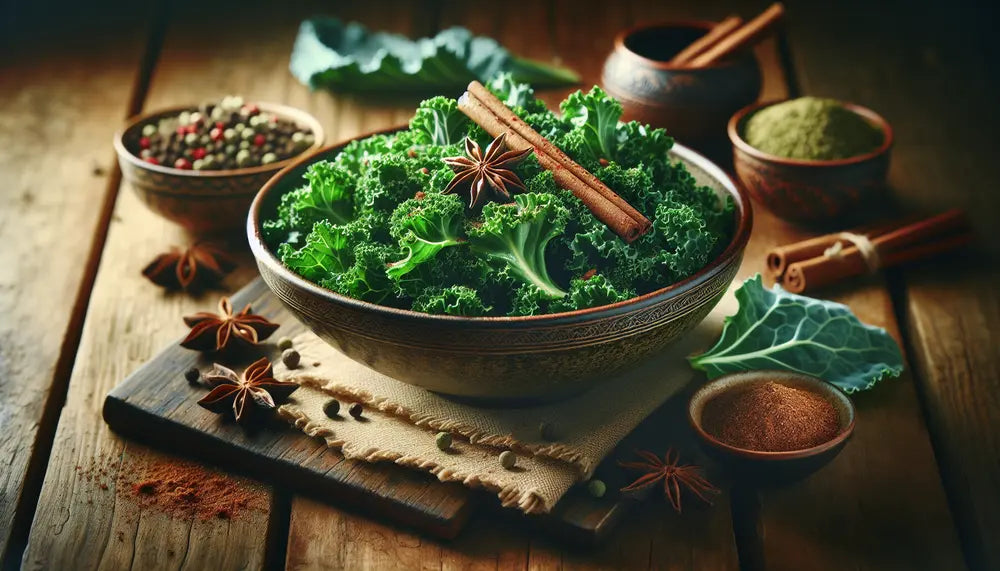Rediscover kale: Innovative spices for unique flavors
Kale, a superfood that is valued not only for its nutrient density in the cold season, can be completely rediscovered with innovative spices. The addition of unexpected flavors transforms the classic winter vegetable into a culinary highlight that enriches both the taste buds and the nutritional value.
Experimenting with **spices from around the world** brings a surprising twist to traditional kale preparation. For example, consider adding **sumac**, a sour-spicy component from the Middle East that gives kale a fresh note. Garam Masala, a mixture of Indian spices, also brings a warm, aromatic depth to the kale. These unusual combinations open the door to a new perception of this traditional vegetable.
Another interesting partner for kale is **lemongrass**. A stalk of it, added during cooking, can introduce a light, citrusy flavor that pairs particularly well with kale's bold nature. In addition to improving the taste, these spices also support digestion and can optimize the absorption of vitamins and minerals.
Using spices rich in **antioxidants**, such as **turmeric** and **ginger**, not only boosts the flavor but also the health benefits of kale. These spices boost its anti-inflammatory properties and can help boost the immune system during the winter months.
To prepare kale with innovative seasonings, start with smaller quantities and taste the dish again and again until the desired intensity is achieved. This way, you can ensure that the seasonings complement the kale without overpowering it. Discovering new seasoning combinations can not only improve your taste, but also enrich your overall cooking experience.
The best seasonings for kale: A selection
The variety of spices has the potential to make kale unconventional and delicious. Here is a selection of the best seasonings to try for your next kale dish:
- Smoked paprika: Gives the kale a subtle smokiness that goes particularly well with rustic dishes.
- Sea salt and black pepper: These classic spices highlight the natural flavor of kale and provide the necessary seasoning.
- cardamom: Adds a slightly sweet and spicy note that pairs well with the tart nature of kale.
- cloves: Bring a warm spice that accentuates the deeper, earthier notes of kale.
- Fennel seeds: Provide a spicy sweetness that enlivens the vegetables and adds a subtle note of anise.
- Chili flakes: Provides a spicy heat that gives kale dishes a kick.
This selection of seasonings can be mixed and matched based on personal taste to transform kale into an exciting side dish or main meal. A good measure for combining spices with kale is to use a pinch of each spice and to taste the dish several times during the cooking time. This ensures that the balance between the individual components remains harmonious.
Seasoning recommendations for a unique kale experience
| Per | Cons |
|---|---|
| Caraway makes kale easier to digest | Caraway flavor is not appreciated by everyone |
| Chili gives a spicy note and enhances the taste | May be too spicy for some people |
| Nutmeg adds a warm, spicy depth | Too much nutmeg can be bitter |
| Ginger gives a fresh, spicy note | The flavor of ginger can be dominant |
Creative seasoning combinations for kale
The creativity in the kitchen allows traditional dishes to be reinterpreted. Here are some inspiring seasoning combinations you can try when preparing kale:
- Mediterranean mix: Combine dried tomatoes, oregano, basil and a little olive oil to create a sunny, southern touch.
- Nordic notes: Dill, mustard seeds and a squeeze of lemon bring fresh and hearty flavors that pair well with the robust character of kale.
- Orient Express: A pinch of cinnamon, star anise and coriander seeds result in an exotically spiced dish that arouses curiosity.
- Tex-Mex twist: Cumin, coriander, and a pinch of cocoa powder give kale an unexpected but delicious Mexican flavor.
These creative combinations can be customized and modified depending on your preferences. The art of seasoning is to balance the flavors so that they complement each other and take the dish to a new level. It's worth experimenting with different blends to find the perfect harmony that makes your kale extra special.
Remember that each spice has its own intensity and the dosage of each ingredient is crucial. A balanced ratio ensures that none of the flavors becomes too dominant. A good example of measurement is a formula that takes flavor strength into account: α + β · α2 = γ, where α, β and γ represent the different spices and their intensities.
How to change the taste of kale with spices
The proper use of seasonings can significantly impact the flavor of kale and turn a simple dish into an extraordinary meal. Here are strategies for using spices to change the flavor profile of kale:
- Enhance flavor: Use sea salt and black pepper to bring out the kale's natural flavors.
- Introduce sweetness: A small amount of honey or maple syrup can balance the bitterness of kale and add a pleasant sweetness.
- Add acid: A squeeze of lemon juice or balsamic vinegar can brighten the flavors and expand the depth of flavor of the kale.
- Generate heat: Spices like chili powder or fresh jalapeños add a pleasant spiciness that pairs well with the robustness of the kale.
- Add earthy notes: Caraway or cumin gives kale earthy undertones that are particularly effective in stews and warm salads.
These changes in seasoning can take kale dishes in entirely new culinary directions. It's exciting to observe how small adjustments in the choice of spices can have a big impact on the final taste of a dish. Try different combinations and discover how versatile kale can be.
By carefully selecting and methodically adding specific spices, you can embark on a journey of taste discovery where simple kale is transformed into an exquisite creation. A good starting point is the concept σ2 = ∑(xi -μ)2, where xi the selected spices and μ represent the medium flavor profile.
Tips for the correct dosage of spices on kale
The dosage of spices plays a crucial role in unlocking the full potential of kale and enhancing its natural flavor without drowning it out. Here are some practical tips on how to use spices effectively when cooking kale:
- Start sparingly: Add spices in small amounts at first, especially when experimenting with new flavors. Tastes are subjective, so it's easier to add more than to correct the taste of an over-seasoned dish.
- Season in layers: Add some spices early in cooking to develop deep, incorporated flavors and others just before serving to preserve some freshness.
- Try and feel: Tastes and preferences vary, so it's important to keep tasting and adjusting accordingly. This will help you get a better feel for the effects of each spice.
- Use a scale: For precise results, especially with dry and strong spices such as cumin or chili powder, it is advisable to use a kitchen scale. The smallest amounts can cause massive differences in taste.
These tips will help you enrich your cooking experience and ensure that your kale dish is not only healthy but also extremely tasty. By gradually adjusting the spice amounts and continually tasting, you will achieve perfection in the art of seasoning. Let the formula Δs = ∑ (ci · Δmi) offer a guideline, where Δs is the shift in the flavor profile, ci is the characteristic of the spice and Δmi represents the quantity variation.
Kale and spices: ideas for every season
Kale is a versatile vegetable that can be combined with various spices depending on the season to offer varied taste experiences all year round. Here are some ideas for seasoning kale:
- Spring: Fresh herbs such as parsley and chives give the kale a light and fresh note. Lemon and mint are also great additions that bring out the spring flavors.
- Summer: Try tropical flavors like mango and coconut mixed with a hint of chili to make kale summery and light. A squeeze of lime can brighten the entire dish.
- Autumn: Warm spices such as cinnamon, nutmeg and cloves blend perfectly with the autumnal atmosphere and enhance the earthy tones of kale.
- Winter: Bold flavors like juniper berries or smoked peppers give kale warmth and a rich depth that's especially flattering in the colder months.
By adjusting seasonings seasonally, kale can be a year-round vegetable that always offers new and interesting flavors. Adapting spices to the respective season not only allows variation in your menu, but also emphasizes the seasonal character of the meals, making every meal a reflective pleasure.
Integrating these spice ideas into your cooking practice could be illustrated by the following mathematical expression: S = Σ(pi · fi), where S is the seasonal flavor contribution, pi represents the presence of the spice in the respective season, and fi represents the intensity of the spice flavor.
Conclusion: Why spices are revolutionizing the kale experience
The application of Seasoning can completely change the culinary experience with kale. Skillful seasoning not only enriches and diversifies the taste, but also increases the attractiveness of this nutrient-rich vegetable. This opens up a wide range of possibilities for innovative and appealing dishes.
Choosing the right spices and their dosage means that kale can be transformed from a simple side dish to a main dish that enhances any meal. What is crucial is that the different spice combinations of each season bring out the best out of the vegetables, which promotes flexibility and creative use in the kitchen.
Ultimately, it is the spices that have the potential to revolutionize and constantly redefine the taste experience with kale. This shows how simple ingredients can be transformed into exquisite delicacies through creativity and culinary know-how. The consistently positive influence of spices on kale is not just a question of taste, but also an expression of cultural diversity that is reflected in our cuisine.
To summarize, the relationship between kale and spices can be mathematically represented by the formula G = Σ(gi · hi) are expressed, where G represents the entire taste experience, gi the individual spices and hi represents their harmonious integration into the court. So we can see that each spice plays an important role in harmony with the properties of the kale and together creates an incomparable culinary experience.
Kale reinterpreted: Five creative seasoning ideas
What unconventional spices can you use for kale?
For an extraordinary taste experience, garam masala, sumac and lemongrass are ideal for giving the kale an exotic touch.
Can you combine kale with fruits and spices?
Yes, combining kale with apples and slightly sweet spices like cinnamon and nutmeg can create an excellent taste experience.
Which spices are suitable for adding a sweet note to kale?
Spices like cloves, anise, and a hint of cinnamon can add a unique sweet and warm flavor to kale.
How to balance the spiciness of kale with spices?
The spiciness of kale can be pleasantly toned down by adding milky products such as coconut milk or milder spices such as cumin and paprika.
Which spices go well with a hearty kale dish?
For hearty kale dishes, classic spices like smoked paprika, black pepper and sea salt are ideal to add strength and depth.





Share:
Delicious creations: spices with the letter K
Spices as a gift: delicious gifts for every occasion